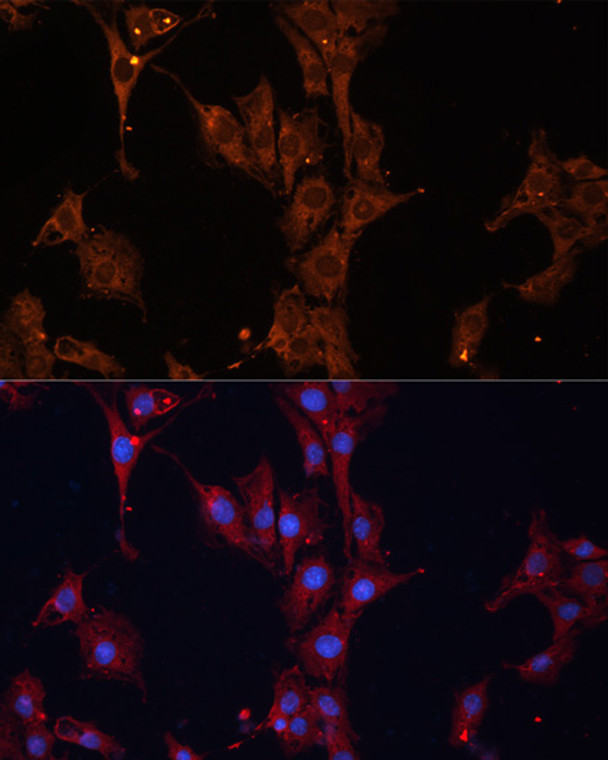| Host: |
Rabbit |
| Applications: |
WB |
| Reactivity: |
Human |
| Note: |
STRICTLY FOR FURTHER SCIENTIFIC RESEARCH USE ONLY (RUO). MUST NOT TO BE USED IN DIAGNOSTIC OR THERAPEUTIC APPLICATIONS. |
| Short Description: |
Rabbit polyclonal antibody anti-HSPB1 (1-100) is suitable for use in Western Blot research applications. |
| Clonality: |
Polyclonal |
| Conjugation: |
Unconjugated |
| Isotype: |
IgG |
| Formulation: |
PBS with 0.02% Sodium Azide, 50% Glycerol, pH7.3. |
| Purification: |
Affinity purification |
| Dilution Range: |
WB 1:500-1:2000 |
| Storage Instruction: |
Store at-20°C for up to 1 year from the date of receipt, and avoid repeat freeze-thaw cycles. |
| Gene Symbol: |
HSPB1 |
| Gene ID: |
3315 |
| Uniprot ID: |
HSPB1_HUMAN |
| Immunogen Region: |
1-100 |
| Immunogen: |
Recombinant fusion protein containing a sequence corresponding to amino acids 1-100 of human HSP27/HSPB1 (NP_001531.1). |
| Immunogen Sequence: |
MTERRVPFSLLRGPSWDPFR DWYPHSRLFDQAFGLPRLPE EWSQWLGGSSWPGYVRPLPP AAIESPAVAAPAYSRALSRQ LSSGVSEIRHTADRWRVSLD |
| Tissue Specificity | Detected in all tissues tested: skeletal muscle, heart, aorta, large intestine, small intestine, stomach, esophagus, bladder, adrenal gland, thyroid, pancreas, testis, adipose tissue, kidney, liver, spleen, cerebral cortex, blood serum and cerebrospinal fluid. Highest levels are found in the heart and in tissues composed of striated and smooth muscle. |
| Post Translational Modifications | Phosphorylated upon exposure to protein kinase C activators and heat shock. Phosphorylation by MAPKAPK2 and MAPKAPK3 in response to stress dissociates HSPB1 from large small heat-shock protein (sHsps) oligomers and impairs its chaperone activity and ability to protect against oxidative stress effectively. Phosphorylation by MAPKAPK5 in response to PKA stimulation induces F-actin rearrangement. |
| Function | Small heat shock protein which functions as a molecular chaperone probably maintaining denatured proteins in a folding-competent state. Plays a role in stress resistance and actin organization. Through its molecular chaperone activity may regulate numerous biological processes including the phosphorylation and the axonal transport of neurofilament proteins. |
| Protein Name | Heat Shock Protein Beta-1Hspb128 Kda Heat Shock ProteinEstrogen-Regulated 24 Kda ProteinHeat Shock 27 Kda ProteinHsp 27Stress-Responsive Protein 27Srp27 |
| Database Links | Reactome: R-HSA-4420097Reactome: R-HSA-450408Reactome: R-HSA-5687128Reactome: R-HSA-9009391 |
| Cellular Localisation | CytoplasmNucleusCytoskeletonSpindleCytoplasmic In Interphase CellsColocalizes With Mitotic Spindles In Mitotic CellsTranslocates To The Nucleus During Heat Shock And Resides In Sub-Nuclear Structures Known As Sc35 Speckles Or Nuclear Splicing Speckles |
| Alternative Antibody Names | Anti-Heat Shock Protein Beta-1 antibodyAnti-Hspb1 antibodyAnti-28 Kda Heat Shock Protein antibodyAnti-Estrogen-Regulated 24 Kda Protein antibodyAnti-Heat Shock 27 Kda Protein antibodyAnti-Hsp 27 antibodyAnti-Stress-Responsive Protein 27 antibodyAnti-Srp27 antibodyAnti-HSPB1 antibodyAnti-HSP27 antibodyAnti-HSP28 antibody |
Information sourced from Uniprot.org
12 months for antibodies. 6 months for ELISA Kits. Please see website T&Cs for further guidance










